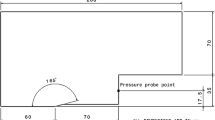Abstract
In this investigation, the effects of spike as retractable drag and aerodynamic heating reduction into the reentry Earth’s atmosphere for hemispherical body flying at hypersonic flow have been numerically studied. This numerical solution has been carried out for different length, shapes and nose configuration of spike. Additional modifications to the tip of the spike are investigated in order to obtain different bow shocks, including no spike, conical, flat and hemispherical aerodisk mounted. Unsteady compressible 3-D Navier–Stokes equations are solved with k − ω (SST) turbulence model for a flow over a forward facing spike attached to a heat shield for a free stream Mach number of 6. The obtained numerical results are compared with the experimental ones, and the results shows acceptable verification. This analysis shows that the aerodisk is more effective than aerospike. The designs produced 60 and 15 % reduction in drag and wall temperature responses, respectively.


























Similar content being viewed by others
Abbreviations
- C f :
-
Surface skin friction coefficient
- C P :
-
Specific heat at constant pressure (J/kg K)
- C p :
-
Static pressure coefficient
- D:
-
Payload shroud diameter (m)
- e:
-
Specific energy (J/kg)
- F, G:
-
Inviscid flux vector
- H:
-
Source vector
- M:
-
Mach number
- p:
-
Static pressure (N/m2)
- Pr:
-
Prandtl number
- q:
-
Heat flux (W/m2)
- Re :
-
Reynolds number
- R, S:
-
Viscous flux vector
- t:
-
Time (s)
- U:
-
Mean stream wise velocity (m/s)
- u, v:
-
Velocity components (m/s)
- W:
-
Conservative variables in vector form
- x, r:
-
Coordinate directions (m)
- μ:
-
Molecular viscosity (kg/m s)
- ρ:
-
Density (kg/m3)
- σrr, σxx :
-
Normal stress tensor (N/m)
- τxr :
-
Shear stress tensor (N/m)
- w:
-
Wall
- 1:
-
Free stream condition
References
Ahmed MYM, Qin N (2010) Math models for aerothermodynamic design optimization of hypersonic spiked blunt bodies. J Aerosp Sci Technol 14:364–376
Ahmed MYM, Qin N (2011) Recent advances in the aerothermodynamics of spiked hypersonic vehicles. J Prog Aerosp Sci 47:425–449
Mehta RC (2002) Numerical analysis of pressure oscillations over axisymmetric spiked blunt bodies at Mach 6.80. Shock Waves J 11:431–440
Crawford DH (1959) Investigation of the flow over a spiked nose hemisphere-cylinder at a Mach number 6.8. NASA TN-D 118
Kenworthy MA (1978) A study of unstable axisymmetric separation in high speed flows. PhD Thesis, Virginia Polytechnic Institute, Mar
Yamauchi M, Tamura Y, Fujii TY, Higashino F (1993) Numerical investigation of supersonic flows around a spiked blunt body. AIAA Paper 93-0887
Hankey W, Shang JS (1984) Numerical simulation of selfexcited oscillations in fluid flows. In: Habashi WG (ed) J Comput Methods Viscous Flows. Pineridge Press, Swansea, 3:543–582
Feszty D, Badcock K, Richards B, Woodgate MA (2000) Numerical simulation of a pulsating flow arising over an axisymmetric spiked blunt body at Mach 2.21 and Mach 6.00. J Shock Waves 10(5):323–327
Ahmed MYM, Qin N (2009) Comparison of response surface and kriging surrogates in aerodynamic design optimization of hypersonic spiked blunt bodies. In: 13th international conference on aerospace sciences and aviation technology
Priyadarshi P, Sivaramkrishnan AE, Ganeshan VR (1995) Static pressure measurement tests on heat shield with and without angle of attack probe. Vikram Sarabhai Space Centre, Trivandrum ATTF/21/94
Chen S, Doolen GD (1998) Lattice Boltzmann method for fluid flow. Annu Rev Fluid Mech 30:329–338
Wolf-Gladrow DA (2003) Lattice-gas cellular automata and lattice Boltzmann models: an introduction (Lecture Notes in Mathematics). Springer
Mehta RC (2000) Heat transfer study of high speed flow over a spiked blunt body. Int J Numer Meth Heat Fluid Flow 10(7):750–769
Barzegar Gerdroodbary M, Hosseinalipour SM (2010) Numerical simulation of hypersonic flow over highly blunted cones with spike. Acta Astronaut 67:180–193. doi:10.1016/j.actaastro.2010.01.026
Yadav R (2011) Aerothermodynamics of a generic missile: the effect of strakelets, dimples, nose cavity and aerodisk. Doctor of philosophy thesis, University of Petroleum and energy studies
Shojaeefard MH, Tahani M, Khalkhali A, Ehghaghi MB, Fallah H, Beglari M (2013) A parametric study for improving the centrifugal pump impeller for use in viscous fluid pumping. Heat Mass Transf 49(2):197–206
Shojaeefard MH, Tahani M, Pirnia A, Fallahian MA (2012) Numerical investigation on effects of induced jet on boundary layer and turbulent models around airfoils. Heat Mass Transf 48:1057–1070
Craft TJ, Launder BE, Suga K (1996) Development and application of a cubic eddy-viscosity model of turbulence. Int J Heat Fluid Flow 17(2):108–115
Kalimuthu R, Mehta RC, Rathakrishnan E (2008) Experimental investigation on spiked body in hypersonic flow. Aeronaut J 112(1136):2008
Jiang Z, Liu Y, Han G, Zhao W (2009) Experimental demonstration of a new concept of drag reduction and thermal protection for hypersonic vehicles. Acta Mech Sin 25:417–419
Ryan M (2009) Supersonic flow instability of blunt bodies with protruding spikes. ACME, Initial Thesis Report
Motoyama N, Mihara K, Miyajima R, Watanuki T, Kubota H (2001) Thermal protection and drag reduction with use of spike in hypersonic flow AIAA paper 2001–1828
Wood CJ (1962) Hypersonic flow over spiked cones. J Fluid Mech 12(Pt. 4):614–627
Author information
Authors and Affiliations
Corresponding author
Rights and permissions
About this article
Cite this article
Tahani, M., Karimi, M.S., Motlagh, A.M. et al. Numerical investigation of drag and heat reduction in hypersonic spiked blunt bodies. Heat Mass Transfer 49, 1369–1384 (2013). https://doi.org/10.1007/s00231-013-1173-4
Received:
Accepted:
Published:
Issue Date:
DOI: https://doi.org/10.1007/s00231-013-1173-4




